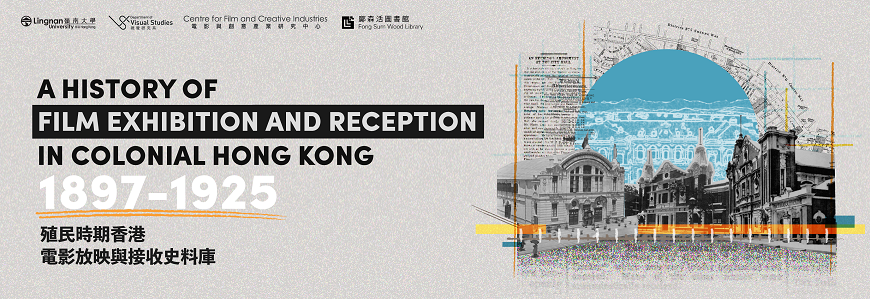A History of Film Exhibition and Reception in Colonial Hong Kong (1897 to 1925)
殖民時期香港電影放映與接收史料庫(1897-1925)
This open-access database developed under the project ‘Screen Practices in Colonial Hong Kong: A History of Film Exhibition and Reception from 1897 to 1925’ is supported by the Research Grants Committee, HKSAR, under the General Research Fund (GRF #LU 12613217). It is presented to serve as an essential resource for research on Hong Kong film history from the initial screenings of motion pictures in the late 1890s to the mid-1920s when the local film industry took shape. It provides online access to more than 29,000 items of news materials, covering movie theatres, distribution companies and circuits, advertisements, and film reviews. These primary materials are expected to help construct the history of early screen practices in Hong Kong.
By ‘screen practices’, we mean two things. First, they refer to screening events, particularly the projection of motion pictures as multi-faceted and multivalent occurrences, such as a technological display, a public assembly for charity, an entertaining performance, and a trendy cultural pursuit. Second, they indicate the domination of exhibition in the cultivation of a film industry before production entered the picture. Exploring the exclusive role of exhibition and the logistics, space, facilities, and equipment required to set up screening events is crucial to understand how movie shows were connected to the social fabric of Hong Kong of the early 20th century. All of this information can be used to explore the formation of the early film industry by identifying screening routines and business transaction patterns.
The term ‘practice’ highlights the repetition of such screening events to achieve some form of proficiency and recognition. The history of screen practices thus reveals the multiplicity and heterogeneity of early Hong Kong film culture, covering the screening equipment, built environment, distribution and exhibition, censorship, and cinema reception as a key part of public life in colonial Hong Kong.
Our research team, led by Professor Emilie Yeh and composed of one research fellow, two Research Officers of the Centre for Film and Creative Industries, and eleven student research assistants, uncovered more than 58,000 primary source materials on film marketing, promotion, exhibition, and reception published from 1897 to 1925 in three major English-language Hong Kong newspapers, namely, the earliest English-language newspaper in Hong Kong, The China Mail (1845–1974); the first local newspaper renowned for its critical views and founded by an American dentist, Robert Fraser-Smith, The Hongkong Telegraph (1881–1951); and the only surviving local English-language newspaper established before WWII, The South China Morning Post (1903–present).
We collected 58,000 relevant news clippings from these three daily papers in microfilm format and converted the clippings into more than 29,000 summarised entries. Each entry contains the date of publication, original title (if any), column/section, and excerpt. We also created four datasets by venues, organisations, key persons, and film projectors and titles, with each data item identified by a tag. The entries that include the same item can be browsed or searched easily using the tag.
We found that typos (in printing or writing) and misspelling of proper names and film titles are not uncommon in these clippings. Our approach to writing the entries is to adhere to the original text, including keeping the errors in the film titles or proper names and the seemingly quaint style of English writing. We inserted the mark [sic] after typos, mistakes, or any nonstandard spelling of words as an indication of verbatim transcription. Yet, 58,000 items make for a vast volume of materials to process. Therefore, we enlisted the help of student research assistants to sort and write the entries over a period of five years. To ensure accuracy and consistency, the records were edited and proofread by the Principal Investigator, Emilie Yeh, and an honorary consultant to the database, Darrell William Davis. Nevertheless, some errors are inevitable; therefore, we plan to continue spot-checking the entries and make corrections wherever necessary.
Emilie Yueh-yu Yeh
Lam Wong Yiu Wah Chair Professor of Visual Studies, Lingnan University
此資料庫為研資局優配研究金資助研究計劃「殖民地香港的映演實踐:電影放映與接收史(1897-1925)」(GRF#LU 12613217)的部分成果。資料庫開放予公眾瀏覽逾29,000項與電影相關的報章資料,包括戲院、片商、發行網絡、電影廣告與電影評論等,並提供自1890年代末至1920年代中期的重要電影資料,以助建構香港早期映演實踐的歷史。
「影幕實踐」指涉:一,影畫放映的多重面向,包括科技展示、慈善聚會、娛樂表演,與影畫作為新興的時髦文化;二,電影行業在未有電影製作前的發展。藉由整理與映演相關的資料,探索放映活動背後的運作、場地、設施與設備,我們方能洞悉影畫與20世紀初香港社會層面的關係。透過查閱放映業界的操作和商業往來,資料庫有助於剖析香港的放映作息及交易,描繪出香港電影行業草創的歷程。
「實踐」一詞強調的是映演活動的頻繁使得放映業日趨完善及備受重視。無論是當年的放映設備與環境、電影發行與上映,以至電影的核准檢查、戲院的經營狀況,映演實踐的各種軼事均能展現早期香港電影文化多姿多彩的面貌,有助進一步了解殖民時期香港的公眾生活。
計畫主持人葉月瑜教授帶領由電影與創意產業研究中心的研究員、研究主任及十一位學生組成的研究團隊,搜集於1897年至1925年間,三份主流英文報紙上刊登逾關電影行銷、宣傳、放映及讀者來函的58,000個資料,編整成為資料庫。三份英文報紙分別為:香港第二份創刊的報紙《德臣西報》﹙1845-1974)、首份由美籍牙醫Robert Fraser-Smith創立及以其批判角度聞名的《士蔑報》﹙1881-1951)及二戰前創刊的報紙中唯一現存的《南華早報》﹙1903-至今)。
團隊將從微縮膠片收集到的58,000條有關報導編纂為逾29,000項概括的條目,並將與映演實踐相關的資料歸類為四個範疇:地點、機構、人物和放映機及電影,每個資料均為獨立的標籤,方便瀏覽其他包含該資料的條目。
原文中有不少舊字及謬處,團隊以貼近原文為原則,保留有誤的內容並加上 [sic] 作為標示。鑒於資料數目龐大,團隊各人共花五年時間整合及編纂條目,所有條目經葉月瑜教授與名譽顧問戴樂為教授校正。但條目仍難免有錯之處,因此團隊將持續校對條目內容,並在必要時作出修改。
葉月瑜教授
嶺南大學林黃耀華視覺研究講座教授


